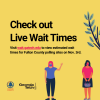news
Georgia Tech’s Secure and Safe Elections Research Group to Provide Live Wait Times to Fulton County Voters on Election Day
Primary tabs
Researchers from Georgia Tech have formed the Safe and Secure Elections research group. The group is developing tools that will allow Fulton County election officials to balance competing demands of election management, help enhance security and safety during the Covid-19 pandemic at polling locations, reduce voting waiting times, and expand access.
By testing the tools in Fulton County, Georgia’s largest county, the Georgia Tech team will be able to solve problems that might be shared by other jurisdictions in the country. The tools will ultimately be available to the general public and election officials nationwide so that people can better understand how public elections are conducted, which increases confidence in their outcome, according to the researchers.
One of the early efforts of the group is to measure and report live wait times to voters at the 250 polling locations in Fulton County on election day, Nov. 3. The website wait.gatech.edu will go live that day and allow users to easily search for a location and view the current estimated wait time. The site also displays wait times recorded throughout the day.
The site is designed to be a utility for voters to help them plan when to vote, and that goal has informed the simple design and usability of the site, according to Ellen Zegura, professor of computer science and a team lead in the research group.
Zegura emphasized that the site does not forecast wait times into the future but rather gives current results based on voter text responses and volunteer observations.
During early voting for the 2020 general election, a student-led team implemented a pilot test at four polling locations in the county. Signs at the polling locations prompted voters to text their wait times after voting. An optional survey let them share more details about equipment quality, Covid-19 concerns, and more. Vlad Kolesnikov, associate professor of computer science who studies cryptography, said the team is mindful of data security and privacy and that no personally identifiable user data is collected or stored.
“By expanding the scope of safe and secure elections from narrow technological problems to addressing physical access, availability, and public health, this project brings a new dimension to the design of modern voting systems,” said Richard DeMillo, principle investigator for the project and chair of Georgia Tech’s new School of Cybersecurity and Privacy.
The election-day effort ties into a larger six-month project by the group that is supported by the Public Interest Technology University Network. It focuses on understanding the quantitative tradeoffs that local election officials are forced to make, and provides tools to help them better manage the voting process. Faculty and students involved in the effort come from the schools of Industrial and Systems Engineering (ISyE), Computer Science, and Cybersecurity and Privacy, as well as the College of Design.
A second project team, led by ISyE Professor Benoit Montreuil, ISyE Director of Professional Practice Dima Nazzal, and ISyE Adjunct Professor and IMT Mines Professor Frederic Benaben, is constructing 3-D maps and AI-based simulations of Covid-safe layouts for a number of Fulton County’s polling places. Their work also involves optimizing voting equipment allocations across all polling locations to minimize wait times, and projections of turn out and waiting times based on historical data and planned equipment provisioning.
“Georgia Tech’s project is a comprehensive effort that puts much-needed tools and design methods in the hands of public officials that not only improve the process of voting but is a vehicle for communicating to the general public that elections can be both fair and safe in these times of public health crises and social unrest,” said DeMillo.
Michael Best, professor in the Sam Nunn School of International Affairs and School of Interactive Computing, is another team lead and has a long track record of working across the globe to help build sustainable election systems.
“The goal is very straightforward. We hope to enhance safety, security, and efficiency at polling locations, which of course should contribute to better voter turnout and trust," said Best.
Volunteers can help the research group in providing live wait times at polling locations to Fulton County voters by observing voters on Nov. 3 and texting wait times, or by helping set up signs Nov. 1 so voters can directly text wait times.
Status
- Workflow status: Published
- Created by: Joshua Preston
- Created: 10/28/2020
- Modified By: Joshua Preston
- Modified: 10/30/2020
Categories
Keywords

